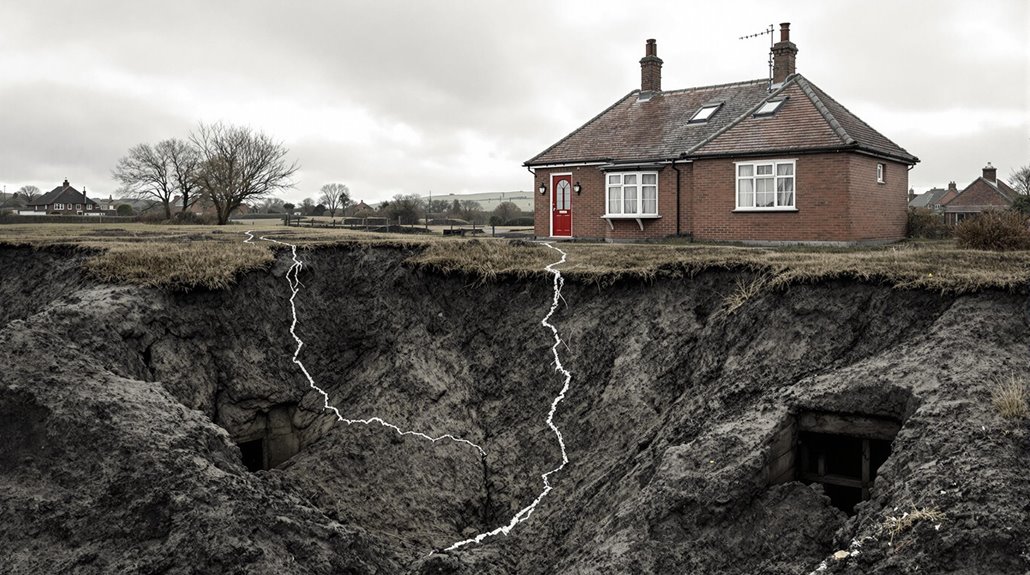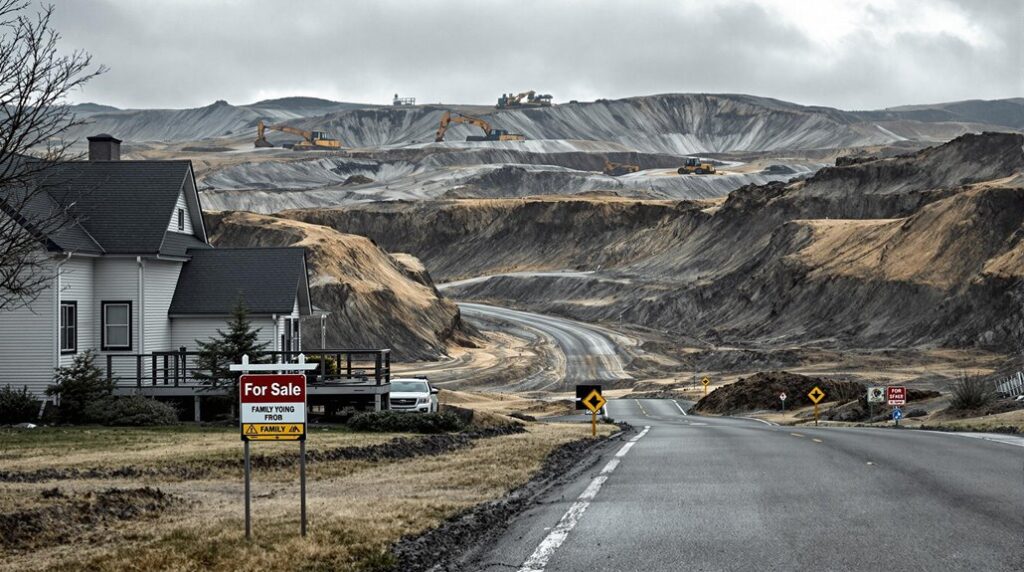I’ve helped countless homebuyers navigate the complex risks of purchasing properties in former mining areas across the UK. What many don’t realize is that both coal and non-coal mining activities can create hidden dangers that won’t show up in a standard survey. From sudden subsidence to dangerous gas emissions, these risks can turn your dream home into a costly nightmare. Let me walk you through the critical assessments you’ll need to protect your investment.
Key Takeaways
- Coal mining affects 17% of UK properties while non-coal mining hazards impact 22% of properties in England and Wales.
- Subsidence from mining can cause severe structural damage and reduce property values by up to 20%.
- Gas emissions and soil contamination from abandoned mines create long-term health risks for families.
- Coal Mining Risk Assessments are legally required in Development High Risk Areas for planning approval.
- CON29M mining searches are essential for securing mortgage approval and property insurance coverage.
Understanding Coal Mining Reports and Property Boundaries

When you’re considering a property in a former coal mining area, you’ll need a thorough coal mining report that examines multiple risk factors within a 20-meter radius of your boundaries. I’ll walk you through what these reports cover and why accuracy matters.
Your report will identify mine entries, assess gas emissions from disused mines, document subsidence risks, and reveal future mining plans. You’ll get proximity data, gas emission levels, historical hazard records, and ground stability classifications.
Here’s where precision becomes essential: when drawing your property boundaries online, use a desktop with a mouse rather than a touchpad. Zoom in carefully and click at each corner, ensuring your yellow boundary line aligns precisely with your actual property edges. Inaccurate mapping compromises your report’s validity. The Mining Remediation Authority’s online search service provides immediate results to determine if a mining report is necessary for your specific property.
Non-Coal Mining Hazards Across the UK
Beyond coal mining lies a more widespread threat that affects nearly a quarter of all properties in England and Wales. I’m talking about non-coal mining hazards, which impact 22% of properties compared to coal’s 17%.
You’ll find these risks are 2-3 times greater in cities like Birmingham, Cardiff, and York. The British Geological Survey has recorded over 35,000 non-coal mines and 2.8 million mining features across our landscape.
What makes this challenging is the sheer variety – we’re dealing with limestone, sandstone, ironstone, chalk, tin, clay, and metalliferous extractions. Each mineral creates unique hazards including ground instability, sinkholes, and subsidence. Underground extraction has been taking place for over 5000 years, creating a legacy of potential surface settlement issues.
I’d recommend checking BGS hazard classifications before purchasing, as these historical workings often remain hidden beneath modern developments.
Subsidence and Structural Damage Risks

While non-coal mining creates widespread risks, subsidence from all mining activities poses the most serious structural threat to UK properties. I’ve seen how tunnel collapses from decayed substructures can devastate homes, like the Burrow Lead Mine incident in 2011. Ground movement in limestone workings has forced families from their properties, as happened in Ferniehill, Edinburgh. Chalk mine openings create life-threatening surface collapses—Gillingham in 2014 and St Albans in 2018 are stark reminders.
You’re facing real financial consequences too. Affected properties lose up to 20% of their value, while persistent stability issues demand expensive engineering solutions. Mine flooding compounds these problems, causing structural failure and contaminated water release. Climate change may worsen ground conditions, making existing mining hazards even more dangerous for property owners. Understanding these risks protects your investment and family’s safety in mining-affected areas.
Gas Emissions and Environmental Contamination
Though structural damage poses immediate threats, environmental contamination from mining activities creates long-term health risks that’ll affect your family for decades. I’ve seen firsthand how abandoned mines contaminate groundwater and soil with cadmium, lead, zinc, copper, and arsenic—metals that persist for centuries.
When you’re house hunting, understand that 2% of Britain’s land shows high mining hazard susceptibility. These contaminants spread through runoff, groundwater infiltration, and flooding, reaching far beyond original mining sites. Your children face neurological damage from lead exposure, while cadmium threatens kidney function through bioaccumulation.
I recommend commissioning environmental soil testing before purchasing. Check if you’re in a floodplain of affected rivers like the Tyne, Wear, or Tamar. The UK government has identified abandoned metal mines as the largest source of metal pollution in English rivers, with thousands of sites contributing to widespread contamination. Remember—you’re joining a community where informed decisions protect our families’ futures.
Risk Assessment Requirements and Protocols
When you’re purchasing property in coal mining areas, local planning authorities require a Coal Mining Risk Assessment (CMRA) for Development High Risk Areas—and you’ll need to understand these protocols whether you’re buying new construction or evaluating existing properties.
The CMRA identifies coal mining features like shafts, adits, and fissures while evaluating risks from subsidence, hazardous gases, and surface instability. You’ll see intrusive site investigations that precisely locate mine entries and establish “no-build” zones around them.
Risk identification protocols use qualitative matrices to assess hazard likelihood and severity, incorporating historical mining data and past incidents. The assessment must demonstrate site suitability through thorough fault mapping, superficial deposit analysis, and gas migration pathway studies before development approval. These reports must be prepared by qualified professionals with relevant expertise in geology, geotechnical engineering, or mining engineering.
Legal Compliance and Insurance Considerations
After completing your Coal Mining Risk Assessment, you’ll face critical legal and insurance requirements that directly impact your property purchase and mortgage approval. I’ll guide you through the essential compliance steps that protect your investment.
You must secure specialized home insurance covering historic mining activity and subsidence. UK Finance member lenders won’t approve mortgages without explicit mining-related coverage in your policy. Compare premiums carefully—they reflect localized mining risks and vary greatly between providers. Additionally, consider the potential for hidden costs related to leasehold ownership that might arise during your purchase.
Your solicitor must conduct CON29M-compliant searches covering both coal and non-coal mining hazards. These searches satisfy regulatory requirements and demonstrate ground stability compliance to lenders. Failing to disclose known mining risks can void your insurance or derail your sale. Abandoned mine shafts may exist without proper documentation, creating hidden liability issues that complicate your legal position.
Remember: inadequate coverage means no mortgage finance, making thorough mining insurance non-negotiable in affected areas.
Conclusion
I’ve outlined the critical mining risks you’ll face when buying UK property. You must obtain thorough coal and non-coal mining reports, assess subsidence potential, and evaluate gas emission risks. Don’t skip the environmental contamination checks or legal compliance requirements. I recommend securing specialized insurance before completing your purchase. These steps aren’t optional—they’re essential safeguards that’ll protect your investment and guarantee you’re not blindsided by costly structural issues or regulatory problems down the line.
References
- https://www.gov.uk/check-if-property-is-affected-by-coal-mining
- https://www.wessexsearches.co.uk/media/342k2rgr/groundsure-non-coal-mining-white-paper.pdf
- https://www.bgs.ac.uk/geology-projects/hazard-and-resilience-modelling/mining-hazard-not-including-coal/
- https://www.allcottassociates.co.uk/blog/mining-and-property-subsidence-does-your-home-sit-on-a-coalfield/
- https://envirosolution.co.uk/the-hidden-dangers-of-coal-mining-how-a-coal-mining-risk-assessment-protects-your-property/
- https://www.gov.uk/guidance/using-coal-mining-information
- https://www.groundstability.com/public/web/home.xhtml
- https://datamine-cauk.hub.arcgis.com
- https://www.youtube.com/watch?v=rsLH18Pj2cY
- https://www.bgs.ac.uk/datasets/mining-hazard-not-including-coal-coverage/

